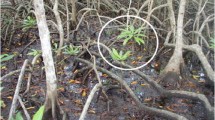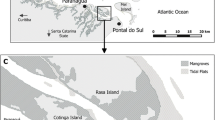Abstract
Litterfall consumption and predation on propagules is high in Indo-west-Pacific mangroves and low in Atlantic-east-Pacific ones. However, data for the latter area comes only from Caribbean and subtropical North American mangroves. South American data on litterfall consumption contradicts this view but data on predation on propagules are scarce. We measured predation on Rhizophora mangle, Avicennia schaueriana and Laguncularia racemosa propagules and seedlings and related to densities of large (>1.5 m high) and small (1–1.5 m) plants in mature and regenerating mangroves in Ceará state, Brazil. Predation on propagules was the highest among American mangroves (R. mange, >47%; A. schaueriana, >97%; L. racemosa, >83%), especially in the regenerating area. Predation on seedlings was low (maximum of 14% for R. mangle) and did not hamper growth. The dominance of large R. mangle trees in the mature mangrove is consistent with the lower predation on its propagules but the high proportions of small plants of other species indicate that dominance is achieved by mechanisms other than predation. In the regenerating mangrove, dominance of large and small L. racemosa and A. schaueriana plants is not consistent with the high predation on their propagules. Therefore, predation is not the main determinant of the species composition in this mangrove system.


Similar content being viewed by others
References
Allen, J. A., K. W. Krauss & R. D. Hauff, 2003. Factors limiting the intertidal distribution of the mangrove species Xylocarpus grantum. Oecologia 135: 110–121.
Berger, U., M. Adams, V. Grimm & H. Hildenbrandt, 2006. Modelling secondary succession of neotropical mangroves: causes and consequences of growth reduction in pioneer species. Perspectives in Plant Ecology, Evolution and Systematics 7: 243–252.
Berger, U., V. H. Rivera-Monroy, T. W. Doyle, F. Dahdouh-Guebas, N. C. Duke, M. L. Fontalvo-Herazo, H. Hildenbrandt, N. Koedam, U. Mehlig, C. Piou & R. R. Twilley, 2008. Adavances and limitations of individual-based models to analyze and predict dynamics of mangrove forests: a review. Aquatic Botany 89: 260–274.
Bosire, J. O., J. G. Kairo, J. Kazungu, N. Koedam & F. Dahdouh-Guebas, 2005. Predation on propagules regulates regeneration in a high-density reforested mangrove plantation. Marine Ecology Progress Series 299: 149–155.
Cannicci, S., D. Burrows, S. Fratini, T. J. Smith III, J. Offenberg & F. Dahdouh-Guebas, 2008. Faunal impact on vegetation structure and ecosystem function in mangrove forests: A review. Aquatic Botany 89: 186–200.
Cunha-Lignon, M., C. Coelho Jr., R. Almeida, R. Menghini, F. Correa, Y. Schaeffer-Novelli, G. Cintrón-Molero & F. Dahdouh-Guebas, 2009a. Mangrove forest and sedimentary processes on the south coast of São Paulo State (Brazil). Journal of Coastal Research SI 56: 405–409.
Cunha-Lignon, M., M. M. Machiques, Y. Schaeffer-Novelli, M. Rodrigues, D. A. Klein, S. C. Goya, R. P. Menghini, C. C. Tolentino, G. Cintrón-Molero & F. Dahdouh-Guebas, 2009b. Analysis of mangrove forest succession, using sediment cores: a case study in the Cananéia-Iguape coastal system, São Paulo, Brazil. Brazilian Journal of Oceanography 57: 161–174.
Dahdouh-Guebas, F., M. Verneirt, J. F. Tack & N. Koedam, 1997. Food preferences of Neosarmatium meinerti de Man (Dacapoda: Sesaminae) and its possible effect on the regeneration of mangroves. Hydrobiologia 347: 83–89.
Dahdouh-Guebas, F., M. Varner, J. F. Tack, N. van Speybroeck & N. Koedam, 1998. Propagule predators in Kenyan mangroves and their possible effect on regeneration. Marine Freshwater Research 49: 345–350.
Dahdouh-Guebas, F., J. G. Kairo, L. P. Jayatissa, S. Cannicci & N. Koedam, 2002. An ordination study to view vegetation structure dynamics in disturbed and undisturbed mangrove forests in Kenya and Sri Lanka. Plant Ecology 161: 123–135.
Deus, M. S. M., E. V. S. B. Sampaio, S. M. C. B. Rodrigues & V. C. Andrade, 2003. Estrutura da vegetação lenhosa de três áreas de manguezal do Piauí com diferentes históricos de antropização. Brasil Florestal 78: 53–60.
Elster, C., L. Perdomo, J. Polania & M. L. Schnetter, 1999. Control of Avicenia germinans recruitment and survival by Junonia evarete larvae in a disturbed mangrove forest in Colombia. Journal of Tropical Ecology 15: 791–805.
Fromard, F., H. Puig, E. Mougin, E. Marty, J. L. Betoulle & L. Cadamuro, 1998. Structure, above-ground biomass and dynamics of mangrove ecosystems: new data from French Guyana. Oecologia 115: 39–53.
Krauss, K. W. & J. A. Allen, 2003. Factors influencing the regeneration of the mangrove Bruguiera gymnorrhiza (L.) Lamk. on a tropical Pacific island. Forest Ecology and Management 176: 49–60.
Krauss, K. W., C. E. Lovelock, K. L. McKee, L. López-Hoffman, S. M. L. Ewe & W. P. Sousa, 2008. Environmental drives in mangrove establishment and early development: a review. Aquatic Botany 89: 105–127.
Lee, S. Y., 2008. Mangrove macrobenthos: assemblages, services and linkages. Journal of Sea Research 59: 16–29.
Lindquist, E. S., K. W. Krauss, P. T. Green, D. J. O′ Dowd, P. M. Sherman & T. J. Smith III, 2009. Land crabs as key drivers in tropical coastal forest recruitment. Biological Review 84: 203–223.
Lugo, A. E. & S. C. Snedaker, 1974. The ecology of mangroves. Annual Review of Ecology and Systematics 5: 39–64.
McKee, K. L., 1995. Mangrove species distribution and propagule predation in Belize: an exception to the dominance-predation hypothesis. Biotropica 27: 334–345.
Medeiros, T. C. C. & E. V. S. B. Sampaio, 2008. Allometry of aboveground plant biomasses in mangrove species at Itamaracá, Pernambuco, Brazil. Wetlands Ecology and Management 16: 323–330.
Miranda, P. T. C., M. L. R. Martins & Z. M. L. Soares, 1988. Levantamento e quantificação das áreas de manguezais no Estado do Ceará (Brasil) através de sensoriamento remoto. In: SIMPÓSIO BRASILEIRO DE SENSORIAMENTO REMOTO, 35. Natal, 1988. Anais. Natal: Sociedade Brasileira de Sensoriamento Remoto 1: 90–94.
Nordhaus, I. & M. Wolff, 2007. Feeding ecology of the mangrove crab Ucides cordatus (Ocypodidae): food quality and assimilation efficiency. Marine Biology 151: 1655–1681.
Nordhaus, I., M. Wolff & K. Diele, 2006. Litter processing and population food intake of the mangrove crab Ucides cordatus in a high intertidal forest in northern Brazil. Estuarine, Coastal and Shelf Science 67: 239–250.
Olafsson, E., S. Buchmayer & M. W. Skov, 2002. The East African decapods crab Neosarmatium meinerti (de Man) sweeps mangrove floors clean of leaf litter. Ambio 31: 569–573.
Oliveira, A. M. E., M. A. Irving & H. H. Lima, 1988. Aspectos bioecológicos do estuário do rio Pacoti, Ceará, Brasil. Arquivo de Ciência do Mar 27: 91–100.
Osborne, K. & T. J. Smith III, 1990. Differential predation on mangrove propagules in open and closed canopy forest habitats. Vegetatio 89: 1–6.
Patterson, S., K. L. McKee & I. A. Mendelssohn, 1997. Effects of tidal inundation and predation on Avicennia germinans seedling establishment and survival in a subtropical mangal/salt marsh community. Mangroves and Salt Marshes 1: 103–111.
Siddiqi, N. A., 1995. Role of crabs in the natural regeneration of mangroves in Sudarbans forest of Bangladesh. Australian Journal of Ecology 20: 340–343.
Smith III, T. J., 1987. Seed predation in relation to dominance and distribution of mangrove forests. Ecology 68: 266–273.
Smith III, T. J., T. H. Chan, C. C. McIvor & M. B. Robblee, 1989. Comparisons of seed predation in tropical tidal forests from three continents. Ecology 70: 146–151.
Sousa, W. P. & B. J. Mitchell, 1999. The effect of seed predators on plant distributions: is there a general pattern in mangroves? Oikos 86: 55–66.
Sousa, W. P., P. G. Kennnedy & B. J. Mitchell, 2003. Propagule size and predispersal damage by insects affect establishment and early growth of mangrove seedlings. Oecologia 135: 564–575.
Souza, M. M. A. & E. V. S. B. Sampaio, 2001. Variação temporal da estrutura dos bosques de mangue de Suape—PE. Acta Botanica Brasilica 15: 1–12.
Twilley, R. R., M. Pozo, V. H. Garcia, V. H. Rivera-Monroy, R. Zambrano & A. Bodero, 1997. Litter dynamics in riverine mangrove forests in the Guayas estuary, Ecuador. Oecologia 111: 109–122.
Author information
Authors and Affiliations
Corresponding author
Additional information
Handling editor: K. McKee
Rights and permissions
About this article
Cite this article
Souza, M.M.A., Sampaio, E.V.S.B. Predation on propagules and seedlings in mature and regenerating mangroves in the coast of Ceará, Brazil. Hydrobiologia 661, 179–186 (2011). https://doi.org/10.1007/s10750-010-0522-2
Received:
Revised:
Accepted:
Published:
Issue Date:
DOI: https://doi.org/10.1007/s10750-010-0522-2




